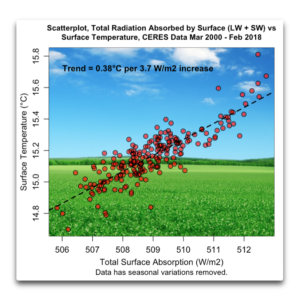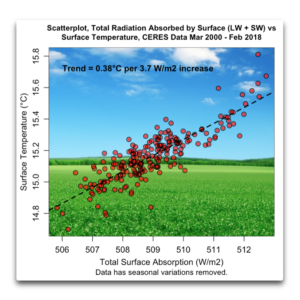by R. Barmby, Jan 23; 2023 in ClimateChangeDispatch
Most people have a firm opinion on whether human emissions of carbon dioxide (CO2) are causing unnatural global warming, and hold that opinion without understanding how the molecule physically absorbs and then releases heat energy.
Understanding that mechanism reveals why today’s significant global CO2 emissions are insignificant to future global warming.
Analogies are a great way to explain science, and I’m going to share the worst and best analogies for how carbon dioxide acts as a greenhouse gas. I will also share why the warming effect of CO2 is limited.
…
…
…
Why Today’s Carbon Dioxide Emissions Are Insignificant To Global Warming
As more CO2 molecules are added as potential absorbers for the fixed amount of the specific band of infrared radiation, there is less chance that any CO2 molecule will be hit. If the additional CO2 molecules do not absorb infrared radiation, they cannot contribute to global warming.
The ever-reducing CO2 contribution to global warming looks like this graph, which, ironically, is based on the IPCC’s formula (from Inconvenient Facts by Gregory Wrightstone):
On the graph above, consider that the pre-industrial (circa 1875) atmospheric CO2 level was about 280 parts per million (ppm), and today it is about 420 ppm—an increase of 140 ppm.
As a rough approximation, the three bars labeled 350, 400, and 450 ppm represent this past increase in CO2, and the sum of the global warming temperature increases associated with those three bars is about 0.7°C.
The next four bars (500, 550, 600, and 650 ppm) represent a future CO2 increase of 200 ppm, which at today’s rate of 2.5 ppm increase each year would take from now to about 2100.
The global warming associated with those four bars is only 0.65°C. The graph shows it keeps taking more CO2 to achieve a smaller amount of global warming.
I chose bars 350 through 650 ppm to highlight that the IPCC’s formula predicts that global warming from current CO2 emissions held flat (1.35°C) would still beat the IPCC’s target of 1.5°C of human-caused global warming from preindustrial times to the year 2100.
The above graph suggests global warming from increasing CO2 never stops, but we know from ancient climates that even 12 times today’s CO2 concentrations did not cause runaway global warming.
Drs. Happer, Koonin, and Lindzen submitted to the U.S. (Northern California) District Court in 2021 that minor changes in cloud cover and convection currents can have a bigger effect on the Earth’s surface temperature than major increases in CO2.
…




